1 Schutztruppe Sergeants Home Uniform
and Südwester Hat
This is standard privately made South West African Schutztruppe
NCOs 1897 home uniform. The tunic has blue facing for South West
Africa, medal bar, aiguillette cords and the collar and cuff
lace and collar button of Sergeant. The trousers are matching as
is the Südwester hat. It is worn with a brown leather belt with
a Schutztruppe NCOs sword. All show signs of wear and tear and
appear to be of genuine pre-1914 Schutztruppe origin.
The medal bar shows the South
West African Medal, the Colonial Medal and the Kaiser Wilhelm I
centenary medal. The ribbons are especially battered and may
have been removed from the bar and reassembled at some point.
The boots worn by this figure are
black leather riding boots and are not likely to have been
original to this uniform as Schutztruppe regulations stated
brown leather boots be worn.
2
Schutztruppe Sergeants Greatcoat
This is a very rare Schutztruppe
NCOs greatcoat. It is standard to regulations, made of grey
cloth with blue shoulder straps and collar patches bearing the
Schutztruppe Litzen and above that a stripe of NCO lace. It
appears to be genuine pre-war Schutztruppe issue and was mostly
likely originally owned by the same Sergeant as the grey home
uniform described above.
3
Schutztruppe Veterans Tunic
Although this tunic is labelled as being of Schutztruppe
issue, from the cut we see that it is in fact a veterans tunic,
made in the 1920s or early 1930s and worn by a member of the Deutsche Kolonialkriegerbund or
DKKB. The tell tale signs are that it
is made in the cut of an 1896 Khaki Drill Tunic but out of
corduroy. The breast pockets flaps are also scalloped rather
than straight as on the Schutztruppe uniform.
4
Schutztruppe Khaki Drill Uniform
This a standard other ranks 1896 khaki tunic with all the
correct Schutztruppe piping, buttons and shoulder straps. It
shows small signs of wear and tear. This tunic appears to be
genuine pre-war Schutztruppe issue.
5
Schutztruppe Kord Litewka with Field Cap
This a standard other
ranks 1900 khaki corduroy Litewka tunic with Schutztruppe
shoulder straps. It shows small signs of wear and tear and is
shown wearing the third pattern of Schutztruppe Mounted
Equipment. Displayed above it is a matching Schutztruppe
corduroy peaked field cap with and imperial cockade and blue
hatband and piping. It also has some wear and what looks like a
tar stain smudging the front. All these items appears to be
genuine pre-1914 Schutztruppe issue.
My only point of contention is
that while they all appear to be genuine Schutztruppe uniform,
the tunic is labelled by the Museum as having belonged to the
Marine Infantry. Schutztruppe uniforms were issued to the Marine
Infantry in South West Africa during the Herero Rebellion but
their Kord Litwekas had grey collars and cuffs, which this one
does not. Also the corduroy field cap has the Schutztruppe blue,
rather than Marine Infantry grey hatband. To me this all seems
to be a Schutztruppe uniform rather than Marine Infantry issue.
6 Naval
Uniform and Cap of the SMS Wittelsbach
This is an imperial naval uniform, consisting of a parade
Affenjacke with the anchor insignia of an Obermaat or
Meistersmaat, naval neck tie collar and blue
naval cap with a tally for SMS Wittelsbach. While this uniform
appears to be totally genuine pre-war imperial naval issue, the SMS
Wittelsbach never served in Africa. Perhaps a veteran of the
ship moved to South West Africa after his naval service?
7 East African
Schutztruppe Südwester
This hat has the white hatband and edging of the East African
Schutztruppe. This is therefore not of South West African
Schutztruppe origin but was worn by a member of the East African
Schutztruppe, possibly one who later moved to South West Africa.
8 Unknown Südwester with Grey
Hatband and Edging
Again this hat appears in excellent condition and is labelled as
being from the South West African Schutztruppe. Yet of course
the South West African Schutztruppe had blue hatbands and
edging, yet this hat has grey. The very first Südwester hats
issued in 1889 had grey hatbands, yet from its excellent
condition I would guess this is probably not that old and has
not seen service in the field for any length of time. The Marine
Infantry also wore grey hatbands during the Herero War, again it
seems in uncannily good condition for that role. The other
option is that the Pfadfinder (a German Youth Organisation in
South West Africa in the 1930s) also wore grey hatbands (as seen
on an example in the Tsumeb Museum in Namibia). It can only be a
guess but this latter option seems more likely than the former
two. 9 Landespolizei Südwester
This item appears entirely genuine with a large gilded Imperial
crown yet its pristine condition
makes it unlikely to have seen service in a desert outpost. It
may be an officers newly purchased hat that never left his desk
job or more likely a post war replica worn by a veteran.
Summary of Authenticity
In my opinion most of these items are genuine Imperial German
pre-war manufacture, with a few from veterans of the immediate
post-war era. Nothing looks like a modern replica or fake and to
my mind the study of antique veterans uniforms is of equal
historical interest to that of the Schutztruppe themselves. It
is also nearly impossible to tell sometimes between pre-war and
post-war privately made items as they were usually made by the
same tailors to the same design. This has caused great confusion
in private collections and museums alike.
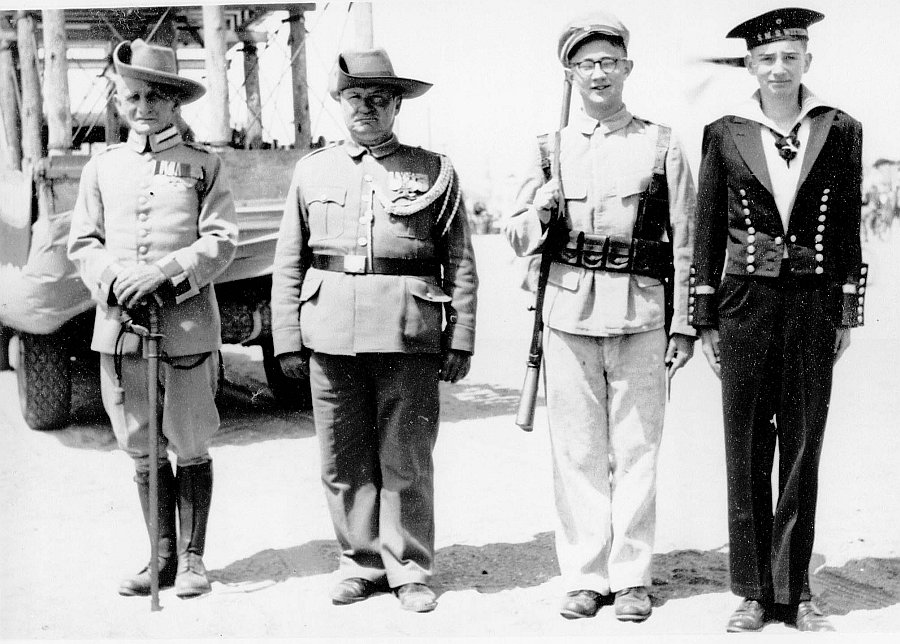
Veterans in Swakopmund c1930s
This is a very curious photograph as it shows four of the uniforms in the
museum's collection perhaps being worn by their original owners. From
left to right the uniforms are:
The Sergeant's Schutztruppe home uniform with medal bar
(with more medals than currently displayed), sword and
Südwester; though he has different boots and gaiters, than those
currently displayed in the Swakopmund
Museum. This man looks elderly and so could well be the original owner
of this uniform. The next
figure wears the DKKB veterans cord uniform
with aiguillette cords and a medal bar. Although a medal bar is
not currently displayed with this uniform, photographs by Phil
Buhler from 2001 show that it did used to be.
Next to
him is a man in the Schutztruppe Kord Litewka, mounted equipment and the corduroy field cap
also seen on display in Swakopmund today.
The man on the right is wearing the sailor's Affenjacke uniform
with cap and tally from the SMS Wittelsbach.
Photos © Frankfurt University Koloniales Bildarchiv |
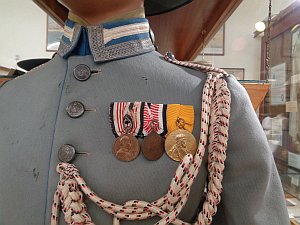
1
Schutztruppe Sergeants Home Uniform
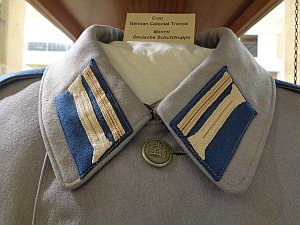
2
Schutztruppe Sergeants Greatcoat
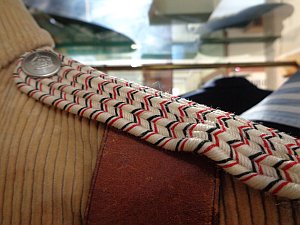
5
Schutztruppe Kord Litewka
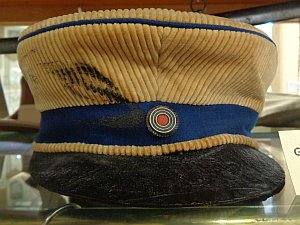
5 Corduroy Field Cap
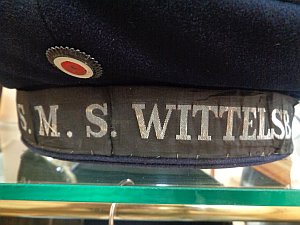
6
Naval Cap of the SMS Wittelsbach
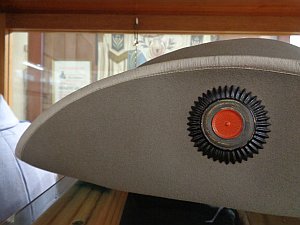
7 East African
Schutztruppe Südwester
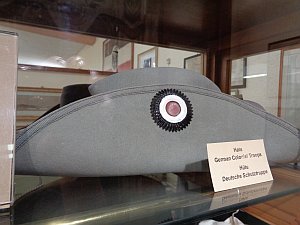
8 Unknown Südwester with Grey
Edging
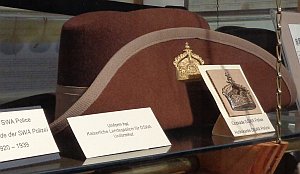
9 Landespolizei Südwester

Swakopmund Museum Collection, 2001
Note the veterans tunic on the left with a medal bar that is
no longer on display.
Photo by
Phil Buhler |